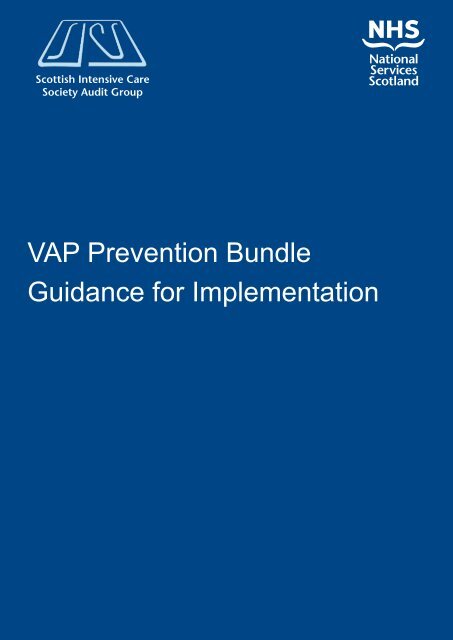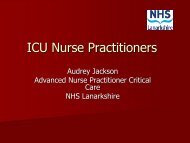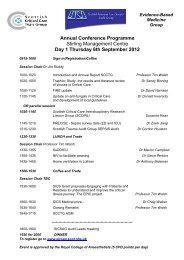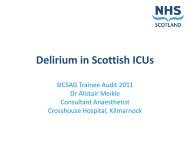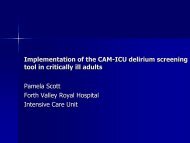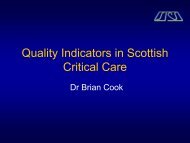VAP Prevention Bundle - The Scottish Intensive Care Society Audit ...
VAP Prevention Bundle - The Scottish Intensive Care Society Audit ...
VAP Prevention Bundle - The Scottish Intensive Care Society Audit ...
Create successful ePaper yourself
Turn your PDF publications into a flip-book with our unique Google optimized e-Paper software.
<strong>Scottish</strong> <strong>Intensive</strong> <strong>Care</strong><br />
<strong>Society</strong> <strong>Audit</strong> Group<br />
<strong>VAP</strong> <strong>Prevention</strong> <strong>Bundle</strong><br />
Guidance for Implementation<br />
i
© NHS National Services Scotland/Crown Copyright 2012<br />
First published January 2008<br />
Brief extracts from this publication may be reproduced provided the source is fully acknowledged.<br />
Proposals for reproduction of large extracts should be addressed to:<br />
ISD Scotland Publications<br />
Information Services Division<br />
NHS National Services Scotland<br />
Gyle Square<br />
1 South Gyle Crescent<br />
Edinburgh EH12 9EB<br />
Tel: +44 (0)131-275-6233<br />
Email: NSS.isd-publications@nhs.net<br />
Designed and typeset by:<br />
ISD Scotland Publications<br />
Document History<br />
Version Date Comment Author QA<br />
1.0 2008/01/09 1st draft of 1st version Dr Brian Cook<br />
2.0 2012/07/16 2nd version Dr Brian Cook<br />
Translation Service<br />
If you would like this leaflet in a different language, large print or Braille (English only), or would like<br />
information on how it can be translated into your community language, please phone 0131 275 6665.<br />
ii
Contents<br />
Introduction......................................................................................................................v<br />
Avoiding invasive ventilation........................................................................................vi<br />
<strong>VAP</strong> <strong>Prevention</strong> <strong>Bundle</strong>...................................................................................................1<br />
1. Sedation is reviewed and, if appropriate, stopped each day..............................2<br />
2. Assess all patients for weaning and extubation each day.................................4<br />
3. Avoid the supine position and aim to have the patient at least 30 o head up....5<br />
4. Use chlorhexidine as part of daily mouth care....................................................7<br />
5. Use subglottic secretion drainage in patients likely to be ventilated for<br />
more than 48 hours.................................................................................................8<br />
Method of humidification................................................................................................9<br />
iii
Introduction<br />
<strong>The</strong> Ventilator Associated Pneumonia (<strong>VAP</strong>) <strong>Prevention</strong> <strong>Bundle</strong> and associated tools were first jointly<br />
published by SICSAG and Health Protection Scotland (HPS) in January 2008. A review of the content<br />
against current available guidelines and evidence has now been undertaken by the Infection Control Team,<br />
HPS to ensure that the key recommendations are still accurate for the prevention of <strong>VAP</strong>, primarily aimed at<br />
the prevention of Healthcare Associated Infections (HAI).<br />
<strong>The</strong> aim of this care bundle is to improve practice, alongside documented evidence of compliance with<br />
evidence based practice aimed at improving patient outcomes. This care bundle has been agreed by<br />
experts in intensive care and infection control, from around Scotland. <strong>The</strong>y have considerable experience in<br />
their own areas of care bundle application and infection control through surveillance. It is also supported by<br />
the <strong>Scottish</strong> Patient Safety Programme http://www.scottishpatientsafetyprogramme.scot.nhs.uk/programme/<br />
resources.<br />
Recommending best practice of this type requires compromise and pragmatism.<br />
<strong>The</strong> following pages explain the rationale and detail each bundle element that can be measured against,<br />
however local adaptation may be deemed appropriate.<br />
<strong>Audit</strong>ing compliance with bundle elements should be undertaken and describing any account of valid<br />
clinical exclusions is essential. <strong>The</strong> full evidence base used to create this bundle can be found at http://<br />
www.hps.scot.nhs.uk/haiic/ic/evidenceforcarebundles.aspx.<br />
<strong>The</strong>se measures are part of an overall strategy to reduce HAIs in intensive care which includes:<br />
••<br />
Hand hygiene,<br />
••<br />
Personal protective equipment,<br />
••<br />
Environmental cleaning.<br />
Clinical practice aimed at preventing <strong>VAP</strong> must be seen in the context of managing patients with respiratory<br />
failure and especially those who require invasive ventilation.<br />
v
Avoiding invasive ventilation<br />
Some patients with acute respiratory failure are suitable for non-invasive ventilation1. Randomised<br />
Controlled Trials (RCTs) investigating the benefit of non-invasive ventilation have used primary outcomes<br />
such as invasive ventilator days, intensive care days and survival. <strong>The</strong>re is good evidence that non-invasive<br />
ventilation improves these outcomes in patients with acute respiratory failure, especially those with an<br />
acute exacerbation of COPD, cardiogenic pulmonary oedema and the immuno-suppressed. Non-invasive<br />
ventilation may be associated with reduced rates of hospital-associated pneumonia, but the main benefit is<br />
in avoiding invasive ventilation.<br />
Similarly, daily assessment of sedation requirement and the suitability for weaning and extubation helps<br />
reduce ventilator and ICU days.<br />
We recommend consideration of non-invasive ventilation, daily assessment of sedation and daily<br />
consideration for weaning and extubation as part of an overall strategy for managing patients with acute<br />
respiratory failure.<br />
Non-invasive ventilation and avoiding intubation should be considered in appropriate<br />
cases<br />
Improved outcome with initial non-invasive respiratory support trying to avoid intubation has been<br />
demonstrated in the following groups 1 :<br />
••<br />
Cardiogenic pulmonary oedema,<br />
••<br />
Acute exacerbation of Chronic Obstructive Pulmonary Disease,<br />
••<br />
Immuno-compromised patients: Pneumocystis infection and solid organ transplant recipients.<br />
Worse outcome with initial non-invasive respiratory support trying to avoid intubation has been<br />
demonstrated in:<br />
••<br />
ICU patients who fail a trial of extubation 2,3.<br />
References<br />
1. Garpestad E, Brennan J, Hill NS. Noninvasive Ventilation for Critical <strong>Care</strong>. Chest 2007; 132(2):711–<br />
20.<br />
2. Keenan SP, Powers C, McCormack DG and Block G. Non-invasive positive-pressure ventilation for<br />
post extubation respiratory distress: a randomized controlled trial JAMA 2002; 87(24):3238-44.<br />
3. Esteban A, Frutos-Vivar F, Niall D et al. Non-invasive positive-pressure ventilation for respiratory<br />
failure after extubation. N Engl J Med 2004; 350:2452-60.<br />
vi
<strong>VAP</strong> <strong>Prevention</strong> <strong>Bundle</strong><br />
<strong>The</strong>re are five key elements to this bundle which if addressed together should minimise the risk of ventilator<br />
associated pneumonia. <strong>VAP</strong> rates should be part of an infection surveillance programme.<br />
1. Sedation to be reviewed and, if appropriate, stopped each day.<br />
2. All patients will be assessed for weaning and extubation each day.<br />
3. Avoid the supine position, aiming to have the patient at least 30 o head up.<br />
4. Use chlorhexidine as part of daily mouth care.<br />
5. Use subglottic secretion drainage in patients likely to be ventilated for more than 48 hours.<br />
Each element is explained with references and exclusions on the following pages.<br />
1
1. Sedation is reviewed and, if appropriate,<br />
stopped each day<br />
Rationale<br />
A RCT of daily sedation breaks versus routine care demonstrated reduced duration of ventilation and<br />
intensive care unit stay in those patients having daily interruptions of sedation under the guidance of the<br />
research team 4 .<br />
Another RCT demonstrated that a nurse-led protocol reduced ventilator time 5 .<br />
This approach requires each ICU to examine their sedation practice and scoring and develop a system that<br />
allows a safe sedation hold policy, see example on page three from NHS Forth Valley.<br />
Note<br />
It is important to remember to review the patient’s analgesic requirements if the sedation remains off.<br />
Measurement criteria<br />
Ensure that sedation is reviewed and if appropriate stopped each day.<br />
Exclusions<br />
1. Paralysed patient.<br />
2. Patient with brain injury, sedated with possible ICP problem.<br />
3. Patient who is difficult to ventilate - coughing/asynchrony.<br />
4. Patient who is difficult to oxygenate ≥70%O 2<br />
or PEEP≥10.<br />
5. Patient receiving therapeutic hypothermia.<br />
6. Patient receiving palliative/terminal care.<br />
2
Example- NHS Forth Valley’s sedation hold policy<br />
<strong>The</strong> following guidance has been used successfully in NHS Forth Valley.<br />
Sedation breaks should ideally occur before 10am. If appropriate consider switching off sedation at the<br />
end of the night shift. In order to maintain patient and staff safety, liaise closely with the nurse in charge and<br />
colleagues.<br />
••<br />
Sedative agents should be stopped, but not disconnected from the patient,<br />
••<br />
Allow the patient to wake,<br />
••<br />
If the patient is co-operative and able to understand commands leave the sedation off,<br />
••<br />
Distressed or agitated patients require re-sedating,<br />
••<br />
Recommence the sedation at half the previous rate,<br />
••<br />
Administer boluses as appropriate / required to achieve safety.<br />
References<br />
4. Kress JP, Pohlman AS, O’Connor MF, Hall JB. Daily interruption of sedative infusions in critically ill<br />
patients undergoing mechanical ventilation. N Engl J Med 2000; 342:1471–77.<br />
5. Brook AD, Ahrens TS, Schaiff R et al. Effect of a nursing-implemented sedation protocol on the duration<br />
of mechanical ventilation. Crit <strong>Care</strong> Med 1999; 27(12): 2609–15.<br />
6. Quenot JP, Ladoire S, Devoucoux F et al. Effect of a nurse-implemented sedation protocol on the<br />
incidence of ventilator-associated pneumonia. Crit <strong>Care</strong> Med 2007; 35(9):2031-6.<br />
3
2. Assess all patients for weaning and<br />
extubation each day<br />
Rationale<br />
Daily screening of the respiratory function of ventilated patients followed by trials of spontaneous breathing<br />
in appropriate patients reduced the duration of mechanical ventilation and was associated with fewer<br />
complications than usual care 7 .<br />
Other RCTs have demonstrated that weaning protocols reduce ventilator times 8,9 .<br />
Measurement criteria<br />
Ensure that all patients are assessed for weaning and extubation each day.<br />
Exclusions<br />
1. Paralysed patient.<br />
2. Patient with brain injury, sedated with possible ICP problem.<br />
3. Patient who is difficult to ventilate - coughing/asynchrony.<br />
4. Patient who is difficult to oxygenate ≥70%O 2<br />
or PEEP≥10.<br />
5. Patient receiving therapeutic hypothermia.<br />
6. Patient receiving palliative/terminal care or PEEP≥10.<br />
References<br />
7. Ely EW, Baker AM, Dunagan DP et al. Effect on the duration of mechanical ventilation of<br />
identifying patients capable of breathing spontaneously. N Engl J Med. 1996; 335:1864-9.<br />
8. Kollef MH, Shapiro SD, Silver P et al. A randomized, controlled trial of protocol-directed versus<br />
physician- directed weaning from mechanical ventilation. Crit <strong>Care</strong> Med. 1997; 25:567-74.<br />
9. Marelich GP, Murin S, Battistella F et al. Protocol weaning of mechanical ventilation in medical and<br />
surgical patients by respiratory care practitioners and nurses: effect on weaning time and incidence of<br />
ventilator- associated pneumonia. Chest 2000; 118:459–467.<br />
4
3. Avoid the supine position and aim to have<br />
the patient at least 30 o head up<br />
Rationale<br />
Sitting ventilated patients up reduces oesophageal reflux, pulmonary aspiration and may prevent <strong>VAP</strong>.<br />
Semi-recumbent positioning has been the subject of a number of studies including RCTs and subsequent<br />
meta-analyses.<br />
Draculovic et al 10 randomized 90 ventilated patients to supine or semi-recumbent positioning. <strong>The</strong>re was<br />
a dramatic reduction in the risk of microbiologically proven <strong>VAP</strong> in the semi-recumbent group, (5 v. 23%).<br />
This means that only six patients would need to be treated in the semi-recumbent position to prevent one<br />
episode of <strong>VAP</strong> (95% confidence intervals 3-23).<br />
Van Nieuwenhoven et al 11 conducted a RCT in 221 ventilated patients. <strong>The</strong> intended 45º backrest elevation<br />
in the experimental arm was not met, despite using research nurses around the clock; however a mean<br />
angle of 28º was achieved. In the control group, a mean angle of 10º was achieved. <strong>The</strong> <strong>VAP</strong> rates in both<br />
arms were low, with little difference (11.6 and 7.3%, respectively).<br />
A meta-analysis of RCTs evaluating the impact of the patient position on the incidence in <strong>VAP</strong> reported<br />
that an angle of 45º rather than 15-30º was associated with a significantly lower incidence 12 , however the<br />
authors acknowledged that this may be difficult to achieve in practice and indeed these data and findings<br />
were challenged in a later published article 13 . Furthermore the NICE patient safety guidance 2 which was<br />
published in 2008 also reports that obtaining an angle of 45º in patient positioning was difficult in practice,<br />
with an angle of around 30º being more practical 14 .<br />
What can we learn from these seemingly disparate findings? Firstly that it is very difficult to achieve 45º<br />
backrest elevation, though elevation to nearly 30º is possible. It may be that avoidance of the supine<br />
position, particularly in patients being enterally fed, is more important than semi-recumbency.<br />
Notes<br />
Backrest elevation should be done whenever practical during patient care.<br />
Bed angle can be checked against the SICSAG <strong>VAP</strong> <strong>Prevention</strong> Bedside Aide-Memoir which has lines at<br />
30º and 45º. This is available on the SICSAG website www.sicsag.scot.nhs.uk.<br />
Measurement criteria<br />
Ensure that the supine position is avoided and aim to have the patient at least 30° head up.<br />
Exclusions<br />
1. Unstable, shocked patient (eg requiring fluid challenges, high dose vasoactive drugs).<br />
2. Unstable pelvic or spinal injury (it may still be possible to tilt the whole bed).<br />
3. Patient receiving palliative/terminal care.<br />
5
References<br />
10. Drakulovic MB, Torres, A, Bauer TT, et al. Supine body position as a risk factor for nosocomial<br />
pneumonia in mechanically ventilated patients: a randomised trial. Lancet 1999; 354: 1851-1858.<br />
11. Van Nieuwenhoven CA, Vandenbroucke-Grauls C, van Tiel FH, et al. Feasibility and effects of the semi<br />
recumbent position to prevent ventilator-associated pneumonia: a randomized study. Critical <strong>Care</strong><br />
Medicine 2006; 34: 396-402.<br />
12. Alexiou VG, Ierodiakonou V, Dimopoulos G, Falagas ME. Impact of patient position on the incidence<br />
of ventilator-associated pneumonia: a meta-analysis of randomized controlled trials. Journal of Critical<br />
<strong>Care</strong> 2009 Dec; 24(4):515-22.<br />
13. Silvestri L, Gregori D, van Saene HK, Belli R, Blazic M. Semirecumbent position to prevent ventilatorassociated<br />
pneumonia is not evidence based. Journal of Critical <strong>Care</strong> 2010; 25(1):152-3.<br />
14. National Institute for Health and Clinical Excellence, National Patient Safety Agency. Technical patient<br />
safety solutions for ventilator-associated pneumonia in adults. NICE 2008 [cited 2012 Jun 19]; Available<br />
from: URL: http://www.nice.org.uk/nicemedia/live/12053/41684/41684.pdf.<br />
6
4. Use chlorhexidine as part of daily mouth<br />
care<br />
Rationale<br />
Oral antiseptics such as chlorhexidine will reduce oro-pharyngeal colonization and hence <strong>VAP</strong>.<br />
Use of a chlorhexidine solution has been shown to be an effective way of reducing <strong>VAP</strong> in mechanically<br />
ventilated patients and this recommendation is consistent across all the current identified sources of<br />
evidence based guidance including systematic reviews and meta-analyses 15,16,17 .<br />
Notes<br />
Various chlorhexidine preparations have been used in clinical trials. It is recognised that the probable<br />
optimal preparation is 2% chlorhexidine, but this is not commercially available in Scotland. 1%<br />
chlorhexidine gluconate gel is available and about 2cm may be applied by a gloved hand to the inside of<br />
each cheek, four times a day.<br />
Chlorhexidine may become colonised by infective organisms such as pseudomonas if contaminated by<br />
careless use, therefore:<br />
••<br />
Tubes of chlorhexidine must be for single patient use,<br />
••<br />
Chlorhexidine gel must be applied with a clean (not sterile) glove donned for the application,<br />
••<br />
Chlorhexidine can be inactivated by toothpaste, a gap of at least two hours should be left between its<br />
application and tooth brushing.<br />
Measurement criteria<br />
Ensure that chlorhexidine is used as part of daily mouth care.<br />
Exclusions<br />
1. Oro-pharyngeal trauma or surgery.<br />
2. Known hypersensitivity to chlorhexidine (rare).<br />
3. Patient receiving palliative/terminal care.<br />
Reference<br />
15. Chan EY, Ruest A, Meade MO, Cook DJ. Oral decontamination for prevention of pneumonia in<br />
mechanically ventilated adults: systematic review and meta-analysis. BMJ 2007 Apr 28; 334(7599):889.<br />
16. Tantipong H, Morkchareonpong C, Jaiyindee S, Thamlikitkul V. Randomized controlled trial and<br />
meta-analysis of oral decontamination with 2% chlorhexidine solution for the prevention of ventilatorassociated<br />
pneumonia. Infect Control Hosp Epidemiology 2008 Feb; 29(2):131-6.<br />
17. Labeau SO, Van d, V, Brusselaers N, Vogelaers D, Blot SI. <strong>Prevention</strong> of ventilator-associated<br />
pneumonia with oral antiseptics: a systematic review and meta-analysis. [Review]. <strong>The</strong> Lancet<br />
Infectious Diseases 2011 Nov; 11(11):845-54.<br />
7
5. Use subglottic secretion drainage in<br />
patients likely to be ventilated for more<br />
than 48 hours<br />
Rationale<br />
Subglottic drainage of potentially contaminated oro-pharyngeal secretions from above the tracheal tube cuff<br />
may prevent aspiration, lower airway colonization and hence pneumonia. Subglottic secretion drainage has<br />
been the experimental arm of six RCTs and one meta-analysis of nearly 900 patients 18,19 .<br />
<strong>The</strong> meta-analysis found that subglottic secretion drainage halved the incidence of <strong>VAP</strong>, particularly during the<br />
first week of intubation of patients expected to be ventilated for more than three days. Additionally, duration of<br />
ventilation was reduced by almost two days and intensive care unit stay by nearly three days.<br />
<strong>The</strong> meta-analysis was well conducted, recognising the heterogeneity of the five trials and attempted to<br />
resolve some of the differences between trials by sensitivity analysis. An important difference was the study<br />
setting; one trial was conducted in a cardiothoracic intensive care unit, with short periods of ventilation and<br />
no statistically significant difference in <strong>VAP</strong> rates between the two study arms. <strong>The</strong> method of diagnosis<br />
was the most important source of heterogeneity, with only one study relying on quantitative analysis of<br />
bronchoscopically obtained secretions. This study demonstrated a reduced chance of <strong>VAP</strong> in the experimental<br />
arm, with seven patients needing to be treated by subglottic drainage to prevent one episode of <strong>VAP</strong> (95% CI<br />
4-43).<br />
It is recognised that endotracheal tubes and tracheostomy tubes with subglottic drainage ports are available,<br />
but there may be cost implications to using them and risks to changing tubes after ICU admission.<br />
Note<br />
Subglottic aspiration ports should be aspirated hourly.<br />
Measurement criteria<br />
Ensure that subglottic secretion drainage is used in patients likely to be ventilated for more than 48 hours.<br />
Exclusion<br />
1. Intubated prior to ICU admission (the risk of re-intubation must be considered; both the immediate risks<br />
of difficult or failed intubation and cardiovascular compromise and late complications such as <strong>VAP</strong>).<br />
2. Local unit decision not to use tube with subglottic suction in this patient after considering individual risks<br />
and benefits.<br />
3. Patient receiving palliative/terminal care.<br />
You may wish to consider providing tracheal tubes with subglottic drainage ports outwith your ICU.<br />
References<br />
18. Dezfulian C. Shojania K, Collard HR, et al. Subglottic secretion drainage for preventing ventilatorassociated<br />
pneumonia: a meta-analysis. <strong>The</strong> American Journal of Medicine 2005; 118:11-18.<br />
19. Lorente L, Lecuona M, Jiménez A, Mora M, and Sierra A. Influence of an Endotracheal Tube with<br />
Polyurethane Cuff and Subglottic Secretion Drainage on Pneumonia. Am. J. Respir. Crit. <strong>Care</strong> Med.<br />
2007; 176: 1079-1083.<br />
8
Method of humidification<br />
Method of humidification has not been convincingly demonstrated to have an overall beneficial effect, but is<br />
worthy of comment.<br />
Traditional humidification of ventilator circuits used heated water humidifiers. While these achieve excellent<br />
heat and moisture contents of inspired gases, there is a risk of bacterial colonization of the condensate that<br />
forms inside the ventilator tubing. This may then be a source for inadvertent lower airway contamination.<br />
Heat and moisture exchange filters may provide adequate humidification and warming of inspired gases.<br />
<strong>The</strong>ir use reduces colonization of the breathing circuit.<br />
Ten small trials have examined <strong>VAP</strong> in patients randomized to receiving either method of humidification.<br />
Pooling the results of these trials together, without taking methodological differences into account, does not<br />
show statistically different <strong>VAP</strong> rates 20 .<br />
It is likely that the method of humidification does not play a significant role in the prevention of <strong>VAP</strong>. Heat<br />
and moisture exchange filters may be preferred on the grounds of cost and ease of use. However, their<br />
dead-space contributes to difficulties in carbon dioxide elimination in patients with ARDS.<br />
Reference<br />
20. http://www.sicsebm.org.uk/<strong>VAP</strong>/HMEs.htm<br />
Produced by:<br />
Dr Brian Cook, Consultant, Royal Infirmary of Edinburgh (Chair SICSAG)<br />
Dr David Swann, Consultant, Royal Infirmary of Edinburgh<br />
Angela Khan, Clinical Coordinator, SICSAG, Information Services Division (ISD)<br />
On behalf of the Healthcare Associated Infection Group of SICSAG:<br />
Dr Malcolm Booth, Consultant,Glasgow Royal Infirmary<br />
Dr Stephen Cole, Consultant, Ninewells Hospital, Dundee<br />
Dr Sally Crofts, Consultant, Ninewells Hospital, Dundee<br />
Catriona Haddow, Senior Information Analyst, SICSAG, ISD<br />
Claire Kilpatrick, Nurse Consultant, Health Protection Scotland<br />
Moranne MacGillivray, Quality Assurance Manager, SICSAG, ISD<br />
Heather Murdoch, Scientist, Health Protection Scotland<br />
Dr Andy Longmate, Consultant, Forth Valley Royal Hospital<br />
Acknowledgement<br />
Version 2.0 of this bundle has been developed in conjunction with Health Protection Scotland, based on<br />
their targeted literature reviews, undertaken in 2011/12 and published at http://www.hps.scot.nhs.uk/haiic/ic/<br />
evidenceforcarebundles.aspx<br />
9
<strong>Scottish</strong> <strong>Intensive</strong> <strong>Care</strong><br />
<strong>Society</strong> <strong>Audit</strong> Group<br />
SD<br />
SC TLAND<br />
10


